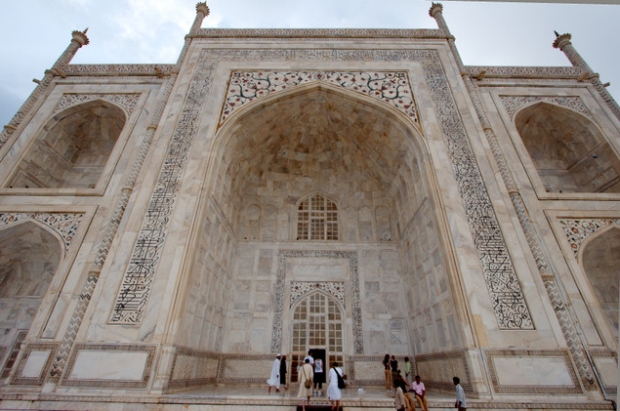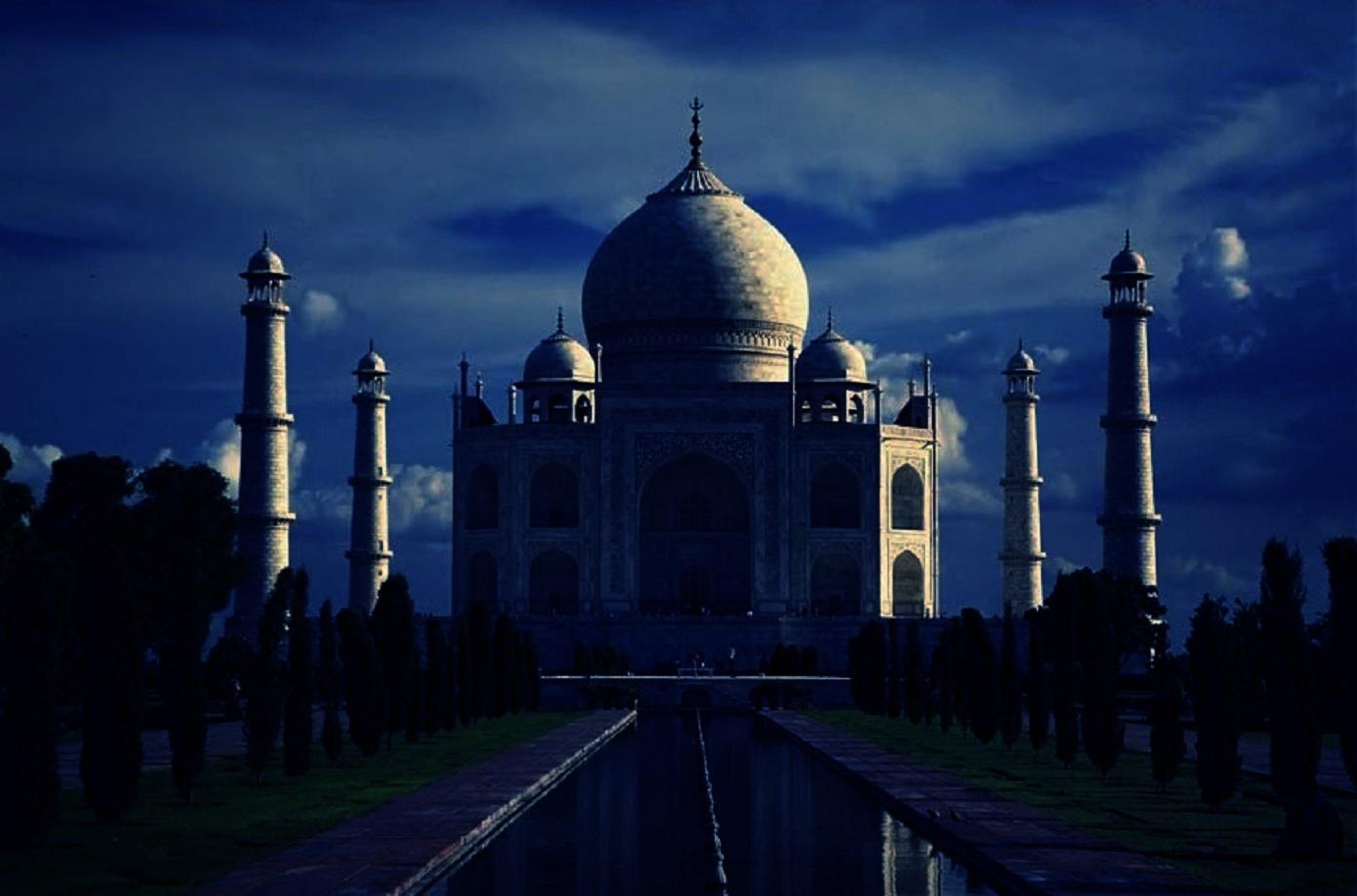The love of a man for his wife is preserved in the gleaming white marble of the Taj Mahal. A vision of symmetry and delicacy, like a perfect pearl set against an azure sky, it is the world’s best-known mausoleum and one of the most exquisite buildings ever designed. On the southern bank of the River Yamuna (Jamuna) at Agra is the Taj Mahal, arguable the most famous building in the world.
Its silhouette is instantly recognizable and has become, for many, the unofficial symbol of India. The fame of the Taj Mahal rests not only on its enduring architectural beauty – in which grandeur and delicacy are miraculously balanced – but also on its romantic associations. It was built by the 17th-century Mogul Emperor Shah Jahan as a memorial to his favorite wife, whose death plunged him into unshakeable grief. As a physical symbol of the devotion of a man to a woman, the Taj Mahal is unsurpassed. Tradition has it that when a couple goes there, the woman should ask her partner: “if I were to die, do you love me so much that you would built me a memorial like this?”
A massive gateway, which in Muslim tradition marks the transition between the realm of the senses and the realm of the spirit, allows entrance to the courtyard of the Taj Mahal. Visitors emerging from its shadows are greeted with the same compelling vision that met the eyes of Shah Jahan more than three centuries ago. The courtyard’s tranquil watercourse mirrors the marble monument’s perfect vertical symmetry.

Shah Jahan, ‘king of the world’ (1592-1666), ruled the Mogul Empire from 1628 to 1658. He was a noted patron of the arts as well as a great builder, and during his reign the empire was at its peak both politically and culturally. When he was just 15 years old, Shah Jahan (known in boyhood as Prince Khurram) met and fell in love with Arjumand Banu Begum, the 14-year old daughter of his father’s prime minister. She was beautiful, intelligent and high-born – seemingly a perfect match – but the prince was obliged to make a traditional ‘political’ marriage to a Persian princess, Muslim law, however, permits a man to take four wives so, in 1612, when the astrological signs ceremony followed a five-year-long betrothal during which the pair did not once set eyes on each other. Her name was changed to Mumtaz Mahal (‘chosen One of the Palace’) shortly afterwards.
Shah Jahan and Mumtaz Mahal had been married for 19 years when, in 1631, the queen died giving birth to their 14th child. The emperor’s grief was as intense as his love. He locked himself away in his apartments without food or drink for eight days, and when he finally emerged, stooped and visibly aged, he ordered the whole kingdom into mourning: music bright clothes, jewellery and even perfume and cosmetics were banned. To glorify Mumtaz Mahal the emperor vowed to build her the most beautiful tomb the world had ever seen. (The name by which it is known – the Taj Mahal – is a variant of the queen’s name).
Work began at Agra, the capital of the Mogul Empire, in 1632 and the grand central building of the Taj Mahal – the mausoleum – was completed in 1643. The mausoleum, however, is only one part of an extensive complex that includes a spacious formal garden, two flanking mosques, fountains, waterways and a stately entrance gateway which is an important building in itself. An inscription records the official date of completion as 1648, but work evidently continued for a few more years.
To complete such a grand scheme in just over 20 years is a remarkable accomplishment utwahe because Shah Jahan had used every resource available in his empire: some 20,000 workmen labored on the construction, and 1000 elephants hauled marble from quarries 200 miles (320km) away. Other materials – and the master craftsmen to work them – came from even farther afield, including malachite from Russia, carnelian from Baghdad and turquoise from Persia and Tibet. An English traveller, Peter mundy, who visited the Taj soon after work had begun, was amazed at the lavishness of the materials: “gold and silver were esteemed common, and marble but as ordinary stone”. Smiths set to work on the silver doors of the grand entrance gate – though these were later stolen by a local Hindu tribe. Masons, inlay specialists, carpenters and calligraphers combined their skills to create an everlasting memorial to one woman.
The Taj Mahal and the two sandstone mosques that flank it stand in marble paved-paved gardens. The visitor’s eye is led to the great horizontal plinth that supports the mausoleum along a straight, narrow watercourse lined with dark green cypresses, in which the shimmering mirror-image of the Taj is perfectly reflected. The bud-shaped dome soars upwards in visual harmony with arches, cupolas and four minarets, built leaning slightly outwards so that if there were an earthquake they would topple away from the building. The splendor of the Taj Mahal is further enhanced by the play of light, particularly at dawn and at dusk when subtle shades of violet, muted hold and rose pink – in varying degrees of softness and intensity – are reflected in the contours of the monument. And in the early morning mist, the building seems to float ethereally in the sky.

While the outside of the Taj Mahal is unique in its perfect symmetry the inside, with its elaborate mosaic work, is also unrivalled central octagonal chamber containing the cenotaphs of the emperor and his wife, enclosed by a perforated marble screen carved in delicate detail and studded with gem-stones. Here, in contrast to the harsh glare outside, soft light filters through the latticed windows and filigree mesh of the intricate marble screen and plays on every surface, illuminating and then gradually concealing in shadow the bejeweled inlay work all around.
Equally impressive by night – when it marble forms are bathed in moonlight and the breeze ripples the waters of the courtyard pool – the world’s most famous mausoleum can arouse powerful emotions in those who gaze on its splendor. The British writer Rudyard Kipling (1865-1936) described the Taj Mahal as “the embodiment of all things pure, all things holy, and all things unhappy. That was the mystery of the building.”

It had been Shah Jahan’s intention to build his own tomb in black marble on the opposite bank of the River Jamuna, linking it with a bridge to symbolize a love that transcended death. But in 1657, before work could begin the emperor fell ill and was deposed a year later by his power-hungry son, Aurangzeb. History is unclear as to precisely where Shah Jahan was imprisoned. The most frequently cited legend claims that for the remainder of his life the emperor was held in the Red Fort at Agra. Following his death in 1666, he was buried in his masterpiece alongside the adored queen who had been its inspiration.
The Taj Mahal fell into disrepair after the decline of the Mogul Empire in the 18th century. In the 19th century, under the British Raj, it was a popular venue for open-air parties, and the music of regimental bands filled its terraces. The Taj Mahal was restored to its former glory as a result of building work instigated by Lord Curzon, a dedicated conservationist and Viceroy of India from 1899 to 1905.



































